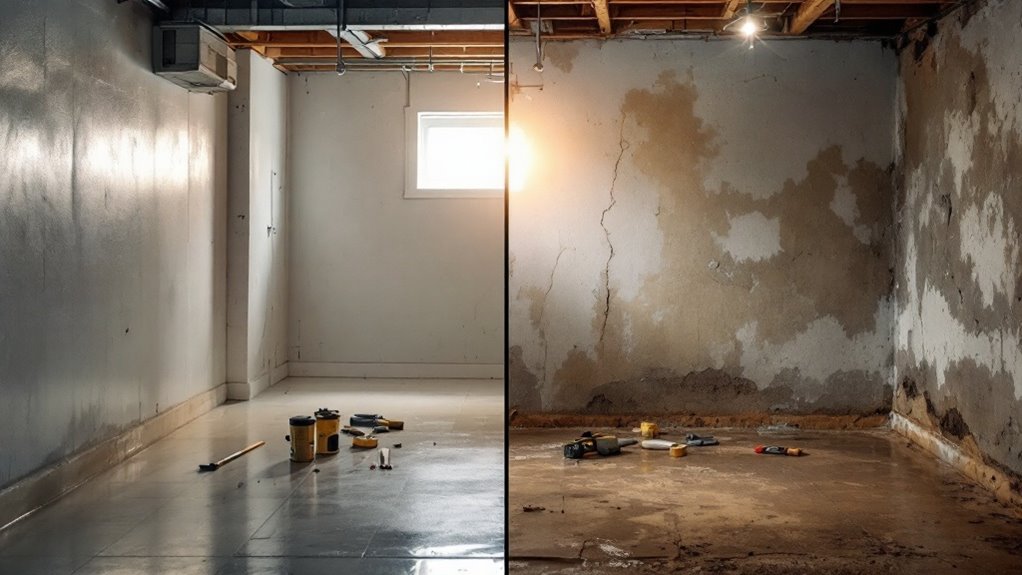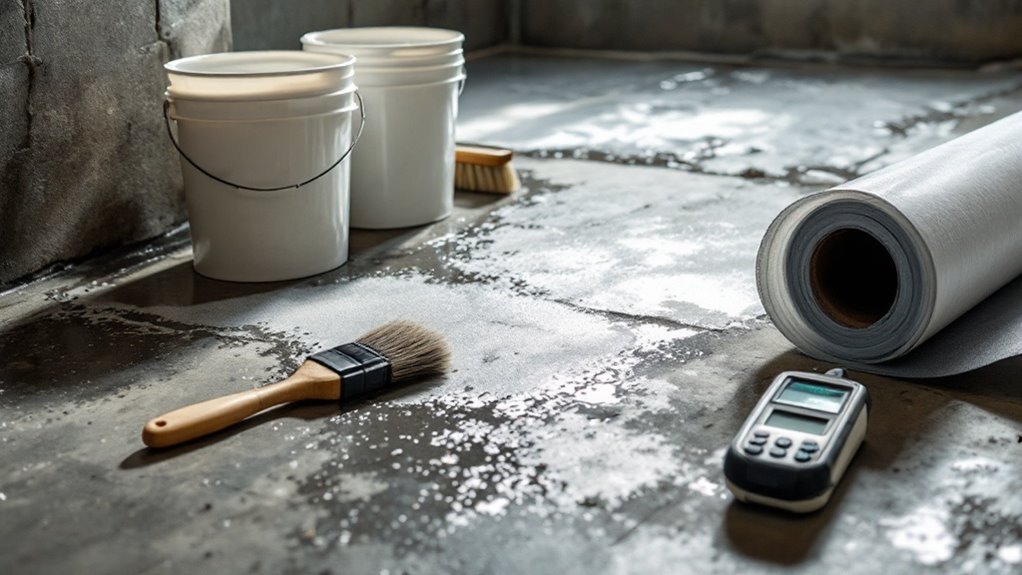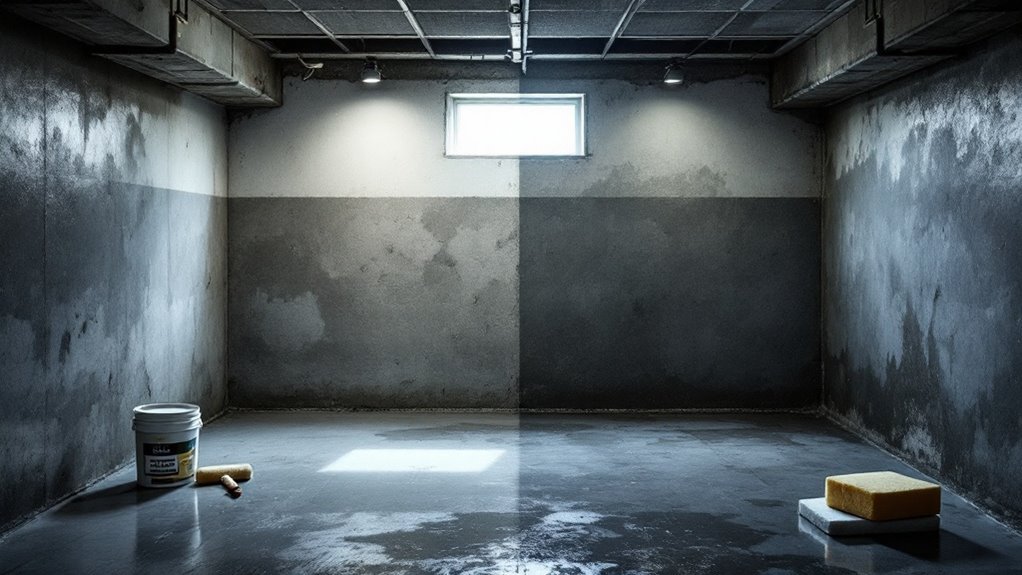Yes, you can DIY waterproof your basement with the right tools and knowledge. Make certain to assess whether you’re dealing with minor or major repairs, as major issues need professional help.
Gather essential materials, maintain safety precautions, and plan your costs and time wisely. Be cautious of risks, like improperly redirecting water.
Understanding long-term solutions is vital for ongoing effectiveness. To guarantee a successful waterproofing project, it’s important to know the necessary steps ahead.
Key Takeaways
- DIY waterproofing can save money, but requires thorough preparation and understanding of minor versus major repairs to avoid costly mistakes.
- Essential tools and materials are necessary for effective waterproofing; proper cleaning and inspection of surfaces are crucial before starting.
- Safety gear like gloves, goggles, and respirators is essential to protect yourself during the waterproofing process.
- Risks include improper repairs leading to further damage; professional help ensures structural integrity and long-term effectiveness.
- Long-term solutions, such as exterior waterproofing and regular maintenance, are vital for preventing future issues in your basement.
Understanding Minor Vs Major Basement Repairs

When you’re evaluating your basement for repairs, it’s essential to differentiate between minor and major issues.
Minor cracks, usually hairline fractures less than 1/8 inch wide, are non-structural and often occur during concrete curing.
Minor cracks, typically hairline fractures under 1/8 inch, are non-structural and commonly result from the concrete curing process.
In contrast, major cracks wider than 1/8 inch indicate significant structural damage and can lead to further issues if left unaddressed. They often appear diagonal and may span entire walls.
While minor cracks can be repaired with caulk or sealants, major ones require professional intervention. Understanding these differences helps you make informed decisions about when to tackle repairs yourself or seek expert assistance. Additionally, professional waterproofing systems are essential for long-term effectiveness against water intrusion.
Essential Tools and Materials for DIY Waterproofing

To successfully waterproof your basement, you’ll need a solid understanding of the sealing products, application tools, and safety gear.
Gather essential materials like PVC channel sections, waterproof adhesive, and dimple boards to get started.
Don’t forget to equip yourself with gloves and masks to guarantee safety during the process.
Sealing Products Overview
Choosing the right sealing products is essential for effective DIY basement waterproofing, as they help prevent water intrusion and protect your home’s foundation. Here’s an overview of key sealing products:
| Product Type | Examples | Purpose |
|---|---|---|
| Sealing Materials for Minor Leaks | Hydraulic cement, silicone caulk | Fill cracks and gaps |
| Channel-Based Systems | SealOnce, adhesive | Redirect water |
| Concrete Sealers | RadonSeal, LastiSeal | Block moisture |
| Joint and Crack Repair | Epoxy, hydraulic cement | Repair structural weaknesses |
Using these products will enhance your basement’s waterproofing effectiveness.
Basement Warning Signs?
Cracks, leaks, or musty smells could signal serious water damage ahead. Act now before minor issues become costly repairs.
- Class-A Licensed & Insured
- Full-Service Construction
- Trusted Local Family-Owned
Application Tools Needed
Successfully waterproofing your basement requires not just the right sealing products but also the essential tools for application.
You’ll need a high-speed drill for securing sections and a wet/dry vac to clean the area before you start. Prepare surfaces with a floor cleaning wheel, scrub brushes, and a spray bottle.
For adhesive application, grab a notched trowel and an adhesive smoother to guarantee a flat finish. Finally, use a tape measure to confirm accurate fitting of all components.
Having these tools on hand will streamline your DIY process and help achieve effective waterproofing.
Safety Gear Essentials
When waterproofing your basement, having the right safety gear is essential to protect yourself throughout the process. Equip yourself with personal protective equipment (PPE) like gloves, goggles, and a respirator. Verify proper ventilation by opening windows or using fans. Prepare surfaces with cleaning agents and scrubbers for effective sealing. Utilize waterproofing products such as sealants and coatings to prevent moisture. Finally, establish support infrastructure like sump pumps and floor drains to manage water overflow.
| Safety Gear | Purpose |
|---|---|
| Gloves | Protect hands from chemicals |
| Safety goggles | Shield eyes from debris |
| Respirator mask | Filter harmful dust/particles |
| Ventilation fans | Improve air circulation |
| Disposable coveralls | Protect skin from exposure |
Cost and Time Considerations for DIY Projects

While considering a DIY waterproofing project for your basement, it’s essential to evaluate both the costs and time commitment involved.
Materials can range from $3 to $7 per square foot, depending on the type of sealant you choose. For a 1,000 sq.ft. basement, you could save over $2,000 by avoiding professional labor costs.
However, expect to invest 2 to 6 weeks on the project, depending on your basement size and your skill level. Remember, larger spaces may push costs closer to hiring professionals, especially if you need specialized materials.
Plan carefully to guarantee the project’s feasibility and success.
Risks of DIY Waterproofing Vs Professional Help
Choosing to tackle basement waterproofing on your own can seem appealing, especially with cost savings in mind.
However, DIY efforts often lead to incomplete sealing and temporary fixes, allowing water to persist. You might miss critical structural assessments, which could worsen underlying drainage issues. Your lack of technical knowledge might result in using incompatible materials or improper application techniques.
DIY basement waterproofing can result in incomplete sealing and overlooked drainage issues, leading to costly long-term problems.
Furthermore, ignoring safety protocols can expose you to harmful chemicals and mold growth. Ultimately, without professional help, you risk costly repairs down the line while missing out on warranties that could protect your investment.
Weigh these risks carefully before proceeding.
Signs You Need Professional Assistance
If you notice structural cracks in your basement walls, it’s a clear sign of instability that needs urgent attention.
Persistent water accumulation, despite your efforts, suggests a more complex issue that might require professional intervention.
Don’t overlook these signs; addressing them early can save you from more extensive repairs down the line.
Structural Cracks Indicate Instability
Noticing structural cracks in your home can be alarming, as they often indicate underlying issues that require professional attention.
Here are some signs that suggest you need expert help:
- Width and Pattern: Cracks wider than ¼ inch or diagonal patterns indicate serious foundation stress.
- Movement: If you notice sagging floors or leaning walls, it’s time to call a professional.
- Gap Formation: Widening spaces between walls and floors signal potential structural separation.
Ignoring these signs can lead to more significant problems, so don’t hesitate to seek assistance for your home’s safety and stability.
Persistent Water Accumulation
When you see persistent water accumulation in your basement, it’s essential to act quickly, as this can signal serious underlying issues. Look for signs like damp carpets, mold growth, or discolored walls. Ignoring these can lead to significant damage and health risks.
| Signs of Water Accumulation | Implications |
|---|---|
| Puddles on basement floor | Internal leaks or exterior issues |
| Mold and mildew growth | Health risks and material damage |
| High indoor humidity | Promotes mold, weakens structure |
| Discolored walls/floors | Indicates leaks or infiltration |
Professional help can address these problems effectively.
Complex Drainage Solutions Required
Complex drainage solutions often become necessary as you encounter persistent water issues in your basement.
If you notice any of these signs, it’s time to call in professionals:
- Hydrostatic pressure leads to cracks in your foundation, indicating serious underlying issues.
- Clogged footing drains due to poorly placed perforated pipes can cause backup and flooding.
- Inadequate exterior drainage from misaligned gutters or improper yard grading can redirect water towards your home.
Attempting DIY fixes for these problems can lead to more damage.
Investing in professional assistance guarantees your basement stays dry and your home remains structurally sound.
Preparation and Safety Steps for Effective Waterproofing
Preparing your basement for waterproofing is essential for guaranteeing a successful outcome. Start by thoroughly cleaning the walls and floors to remove any dirt, dust, or mold.
Strip old coatings that might hinder sealant adhesion and check for dryness, as damp surfaces can compromise effectiveness. Inspect for cracks, gaps, or water stains, and document moisture patterns.
Wear PPE like gloves and goggles, and guarantee proper ventilation. Apply sealants evenly and prioritize sealing cracks first.
Finally, verify structural stability before working and avoid high-humidity conditions. Following these steps will set you up for a successful waterproofing project.
Evaluating Long-Term Solutions for Basement Waterproofing
As you assess long-term solutions for basement waterproofing, it’s essential to understand the various options available and their effectiveness in preventing water intrusion.
Consider these three key solutions:
- Exterior Waterproofing: Installs a waterproof membrane around the foundation, ideal for high water table areas.
- Interior Drainage Systems: Utilize French drains and sump pumps to manage frequent leaks effectively.
- Foundation Crack Repair: Seals cracks with epoxy or polyurethane, addressing underlying issues for lasting protection.
Each option requires professional installation and regular maintenance, ensuring your basement remains dry and secure for years to come.
Should you DIY waterproofing your own basement?
While DIY waterproofing can save you money, it’s essential to weigh the risks. Did you know that nearly 60% of basements in the U.S. experience some form of water damage? This statistic underscores the importance of addressing water issues effectively.
If your project feels overwhelming or the damage is extensive, don’t hesitate to call a professional.
Remember, a well-waterproofed basement can protect your home and belongings for years to come.





